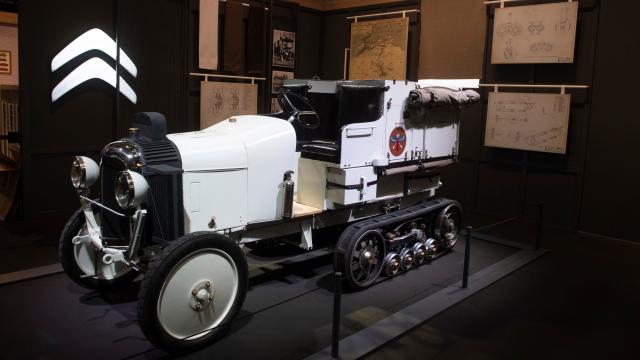This Citroën doesn’t have hydropneumatic suspension. It doesn’t have front-wheel drive. It doesn’t even have recognisable rear wheels. But it (or rather one very much like it) crossed the Sahara back in 1922, and that’s reason enough for Citroën to celebrate it at Rétromobile 2020.
You see, back in the ‘20s (and up until 1962), Algeria was part of France. Of course, most people there lived along the beachy northern coast, but France’s colonial possessions stretched deep into the sweltering heat of the country’s Saharan interior, and by 1922 it was time someone made their way across it by car, or at least the closest thing that could make the journey in one piece.
So, in December of that year, André Citroën sent two of his friends, Georges-Marie Haardt and Louis Audouin-Dubreuil (as well as a whole host of support) to Algeria to cross the Sahara in a set of five half-tracks designed specifically to cope with the desert’s notoriously hostile conditions.
The five half-tracks, named Golden Scarab, Silver Crescent, Flying Turtle, Sacred Cow, and Crawling Caterpillar, were based on Citroën’s Type B2 10CV saloon car. Except where the production Type B2 had a more or less standard rear axle, the Golden Scarab and its fleet-mates had a set of Kégresse tracks that allowed the half-tracks to distribute their weight more broadly and glide over Saharan sand that would strand even the most capable four-wheeled vehicle.
It’s worth exploring the technology behind these treads for a minute because though they look similar, they’re a distinct technology from the caterpillar tracks we’re all most familiar with. First designed by French engineer Adolphe Kégresse for the Tsar’s army before the Russian Revolution, these tracks are made of rubber and canvas rather than the metal links that you might find on most other tracked vehicles.
So, equipped with the latest in all-terrain technology, Haardt and Audouin-Dubreuil set off for the 3600-kilometre journey from the Touggourt on the Mediterranean coast to Timbuktu on the other side of the desert. The going was rough, but they, along with their vehicles, made it. They did what no one had done before and crossed the Sahara under motor power. Enthused by their successful journey, they decided to double their challenge and drive back.
In another first, the convoy was followed closely by people at home in France. Thanks to another recent innovation, the radio, word of every move the half-tracks took on their way to Timbuktu could be beamed home to the Metropole where the expedition was the talk of the town. France was proud of their adventurers and they were proud of Citroën.
The success of this expedition led Haardt and Audouin-Dubreuil to take on two more expeditions, the incredibly racistly-named Black Expedition across central Africa and Yellow Expedition to East Asia, each with a new set of half-tracks that improved on the designs of the ones used prior. It was on that second trip that Haardt would succumb to illness and die in Hong Kong in 1932.
Since then, Citroëns of all kinds have taken to rough terrain, usually as part of rallies. Twin-engined 2CV Saharas supported oil exploration in Northern Africa and SMs braved dunes as well in the Safari Rally of East Africa. More recently, Citroën WRC cars have slid around on snow, too. With these expeditions and all of these other examples in mind, it’s hard to say that Citroën doesn’t have any off-road pedigree, even if every SUV it’s ever built has been basically a normal car.
Now, I should be clear that the vehicle displayed at Retromobile wasn’t a part of the original fleet that made it to Timbuktu as part of the first expedition. Nor did it take part in either of the subsequent adventures. Rather, it’s a reproduction of the Golden Scarab, painstakingly built by students and faculty from the Arts et Metiers engineering school and the Chateau d’Epluches professional school. All in, the work took more than 50,000 hours of work, according to Citroën. That’s an awful lot, but I’ll take their word for it because the result was damn impressive, and these expeditions deserve that kind of tribute.
The recreation Golden Scarab made its debut last year at Citroën’s centennial celebration in Paris, but the half-track was just too damn interesting to keep to themselves afterward. So this year Citroën took it to Rétromobile as well. There, the brand was celebrating the 50th anniversary of its famous GS midsized car, and while that was plenty exciting, it’s hard to say that the Golden Scarab didn’t steal the limelight a bit. I mean look at it. It’s a Citroën half-track. What else do you really need?
